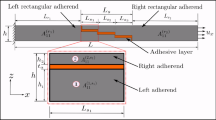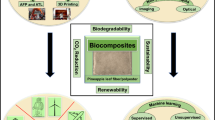Abstract
The deformation and fracture behavior of metal matrix composites with a reaction layer at the fiber-matrix interface was studied by means of a computer simulation experiment, using a two-dimensional model, and the results of the simulation experiment were compared with the predictions based on the single fiber model, which has been proposed to describe the reduction of strength of composites due to a reaction layer. In the simulation experiment, the composite was regarded as an assembly of single fiber elements, in which, for each element, the reaction layer introduces a notch on the fiber surface when it is broken, which reduces the strength of the fiber if the thickness of the layer is thinner than a critical value, as has been studied by using the single fiber model. The strength of composites was reduced with increasing thickness of the reaction layer and the fracture mode became catastrophic. The strength values obtained by the simulation were equal to those based on the single fiber model only when the fracture of the fiber was caused by the extension of the notch having been introduced by premature fracture of the reaction layer. In other cases, the strength values of the simulation were lower than those predicted by the single fiber model, although the single fiber model gave approximate values.
Similar content being viewed by others
References
A. G. Metcalfe and M. J. Klein:Composite Materials, Academic Press, New York and London, 1974, vol. 1, pp. 125–68.
M. A. Wright and B. D. Intwala:J. Mater. Sci., 1973, vol. 8, pp. 957–63.
R. J. Hill and W. F. Stuhrke:Fib. Sci. Tech., 1968, vol. 1, pp. 25–42.
F. Galasso, B. Boundeau, and F. Galasso:Fib. Sci. Tech., 1969, vol. 2, pp. 89–95.
P. W. Heitman, L. A. Shepard, and T. H. Courtney:J. Mech. Phys. Solids, 1973, vol. 21, pp. 75–89.
A. G. Metcalfe:J. Comp. Mater., 1967, vol. 1, pp. 356–65.
D. W. Petrasek and J. W. Weeton:Trans. TMS-AIME, 1964, vol. 230, pp. 977–90.
A. G. Metcalfe and M. J. Klein: Tech. Rep. AFML-TR-71-189.
H. H. Grimes, R. A. Lad, and J. E. Maisel:Metall. Trans. A, 1977, vol. 8A, pp. 1999–2005.
I. H. Khan:Metall. Trans. A, 1976, vol. 7A, pp. 1281–89.
S. Ochiai, K. Shimomura, M. Mizuhara, and Y. Murakami:Trans. Japan Inst. Metals, 1975, vol. 16, pp. 463–71.
S. Ochiai, K. Abe, and K. Osamura:J. Japan Inst. Metals, 1984, vol. 48, pp. 1028–34.
S. Ochiai, K. Osamura, and Y. Murakami:Progress in Science and Engineering of Composites, JSCM, Tokyo, 1982, pp. 1331–38.
S. Ochiai and Y. Murakami:J.Mater.Sci., 1979, vol. 14, pp. 831–40.
S. Ochiai and Y. Murakami:Metall. Trans. A, 1981, vol. 12A, pp. 1155–62.
S. Ochiai, S. Urakawa, K. Ameyama, and Y. Murakami:Metall. Trans. A, 1980, vol. 11 A, pp. 525–30.
S. Ochiai and Y. Murakami:Z. Metallkunde, 1981, vol. 72, pp. 827–31.
S. Ochiai, Y Irie, K. Osamura, and Y. Murakami:Z. Metallkunde, 1983, vol. 74, pp. 44–48.
S. Ochiai, K. Osamura, and Y. Murakami:Z. Metallkunde, 1983, vol. 74, pp. 68–73.
S. Ochiai, K. Osamura, and Y. Murakami:Z. Metallkunde, 1984, vol. 75, pp. 231–37.
S. Ochiai, K. Osamura, and Y. Murakami:Z. Metallkunde, 1984, vol. 75, pp. 238–42.
M. Kh. Shorshorov, L. M. Ustinov, A. M. Zirlin, V. I. Olefirenko, and L. V. Vinogradov:J. Mater. Sci., 1979, vol. 14, pp. 1850–61.
W. Weibull:J. Appl. Mech., 1951, vol. 18, pp. 293–97.
S. Ochiai, K. Osamura, and K. Abe:Z. Metallkunde, 1985, vol. 76, pp. 402–08.
S. Ochiai and K. Osamura:Z. Metallkunde, 1985, vol. 76, pp. 485–91.
C. Zweben:Eng. Frac. Mech., 1974, vol. 6, pp. 1–10.
S. Ochiai, K. Abe, and K. Osamura:J. Japan Inst. Metals, 1984, vol. 48, pp. 1021–27.
S. Ochiai, K. Abe, and K. Osamura:Z. Metallkunde, 1985, vol. 76, pp. 299–306.
H. W. Herring, J. L. Lytton, and J. H. Steele, Jr.:Metall. Trans., 1973, vol. 4, pp. 807–17.
Author information
Authors and Affiliations
Rights and permissions
About this article
Cite this article
Ochiai, S., Osamura, K. A computer simulation of strength of metal matrix Composites with a Reaction Layer at the Interface. Metall Trans A 18, 673–679 (1987). https://doi.org/10.1007/BF02649483
Received:
Published:
Issue Date:
DOI: https://doi.org/10.1007/BF02649483




